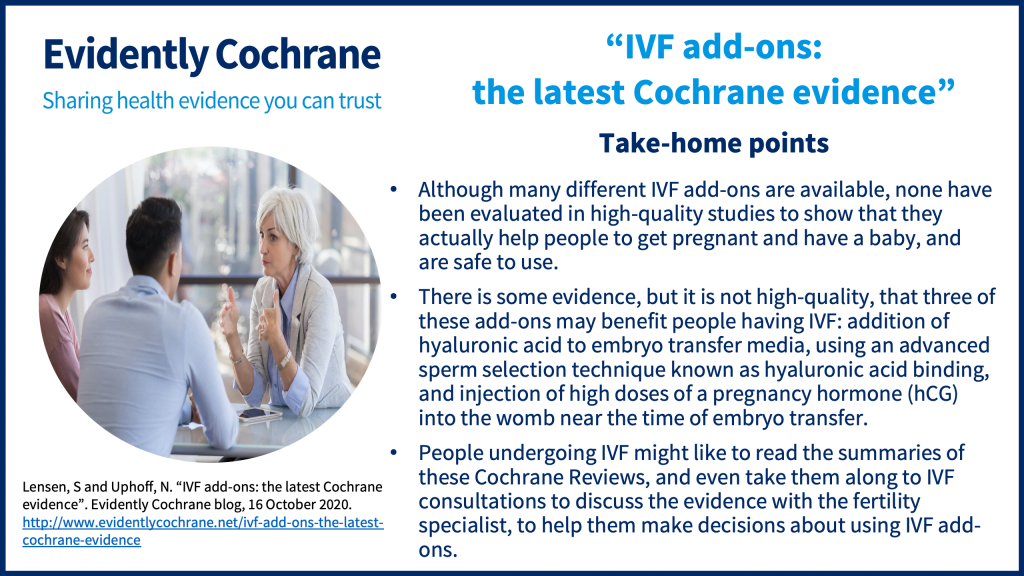In this blog for people undergoing IVF, Sarah Lensen (Cochrane editor) and Noortje Uphoff (IVF patient) look at the latest Cochrane evidenceCochrane Reviews are systematic reviews. In systematic reviews we search for and summarize studies that answer a specific research question (e.g. is paracetamol effective and safe for treating back pain?). The studies are identified, assessed, and summarized by using a systematic and predefined approach. They inform recommendations for healthcare and research. on IVF add-ons, as part of the new Cochrane Special Collection: In vitro fertilisation – effectiveness of add-ons.
Page last checked 26 June 2023
Take-home points

“During our first round of IVF, we were given the option to use embryo glue to help the embryo ‘stick’. We could also opt for ‘embryo time lapse imaging’ so that the embryologist could make detailed observations of embryos as they developed each day in the lab, without disturbing them. We looked at the evidence from Cochrane ReviewsCochrane Reviews are systematic reviews. In systematic reviews we search for and summarize studies that answer a specific research question (e.g. is paracetamol effective and safe for treating back pain?). The studies are identified, assessed, and summarized by using a systematic and predefined approach. They inform recommendations for healthcare and research. to help our decision making. It was important to us to know whether these optional extras would do no harm. Making these decisions was difficult. We had to weigh up the additional costs and our wish to do everything we could to make IVF work for us. We were successful after three IVF treatmentSomething done with the aim of improving health or relieving suffering. For example, medicines, surgery, psychological and physical therapies, diet and exercise changes. cycles and our baby is due to arrive in a few weeks. If we use IVF again in the future, I hope to look at the Cochrane Library and find that more robust evidence on the effectivenessThe ability of an intervention (for example a drug, surgery, or exercise) to produce a desired effect, such as reduce symptoms. and safetyRefers to serious adverse effects, such as those that threaten life, require or prolong hospitalization, result in permanent disability, or cause birth defects. of add-ons has emerged!” – Noortje Uphoff.
In vitro fertilization (IVF)
Many couples have trouble getting pregnant and may turn to IVF for help. People also undergo IVF for other reasons, such as needing genetic testing of their embryos for a known inherited disorder or single women who wish to have a baby. Unfortunately, the success rateThe speed or frequency of occurrence of an event, usually expressed with respect to time. For instance, a mortality rate might be the number of deaths per year, per 100,000 people. of IVF is mediocre. Although the success of IVF depends on many factors, including the age of the women, the overall chance of getting pregnant and having a baby from IVF is approximately 20-30% per IVF cycle.
In 1978, Louise Brown was the first baby born using IVF. In the last 40 years IVF technology has undergone many important advancements, including ovarian stimulation to allow the collection of multiple eggs in a single cycle instead of just one, injection of sperm directly into eggs to allow IVF to treat couples with male-factor infertility, and freezing of embryos and eggs so they can be used in the future. The field of IVF is constantly advancing and introducing new techniques or treatment options, with the hopes that they will improve the chances of having a baby for the 1 million people who undergo IVF across the world every year.
What are IVF add-ons?
When people undergo IVF, they are often provided with additional options to consider as part of their IVF treatment. This might include extra procedures, medicines, or laboratory techniques. We call these optional extras IVF ‘add-ons’. Examples include taking extra medications such as steroids or aspirin, dipping the embryo into an extra solution known as embryo glue just before it is transferred into the womb, or genetic testing of embryos for extra chromosomes when there is no known inherited disorder present. IVF add-ons are normally offered or available at IVF clinics with the aim or hope that they may help people to conceive and have a baby from IVF. Because they are additional to standard IVF, add-ons usually come at an extra cost to patients. The cost will vary depending on the add-on, but can be anywhere between a few pounds and thousands of extra pounds. Different IVF clinics may choose to make different add-ons available, and some IVF clinics don’t use any add-ons.
The evidence for IVF add-ons
Just like every interventionA treatment, procedure or programme of health care that has the potential to change the course of events of a healthcare condition. Examples include a drug, surgery, exercise or counselling. in health care, it is important that new treatment options are robustly evaluated in scientific studies to confirm that they are effective and safe. People having IVF should have access to information about the evidence of risks and benefits of IVF add-ons when making decisions about whether to use them. This may be especially important in the setting of IVF where concerns about safety include the patient but also a potential pregnancy.
In this Special Collection, we have collated all the Cochrane Reviews that evaluate different IVF add-ons. We have only included reviews that were completed in the last 5 years, to make sure the evidence is up-to-date.
These Cochrane reviews found that none of the IVF add-ons are supported by high-quality evidence that the add-on is effective and safe. In most cases, the included studies suffered from limitations, such as riskA way of expressing the chance of an event taking place, expressed as the number of events divided by the total number of observations or people. It can be stated as ‘the chance of falling were one in four’ (1/4 = 25%). This measure is good no matter the incidence of events i.e. common or infrequent. of biasAny factor, recognised or not, that distorts the findings of a study. For example, reporting bias is a type of bias that occurs when researchers, or others (e.g. drug companies) choose not report or publish the results of a study, or do not provide full information about a study. and small sample size, which result in uncertainty about whether the add-on is beneficial, harmful or has no effect – it was not possible to tell.
For three add-ons, there was some evidence of possible benefit, however the evidence was not high quality:
- addition of hyaluronic acid to embryo transfer media
- using an advanced sperm selection technique known as hyaluronic acid binding
- injection of high doses of a pregnancy hormone (hCG) into the womb near the time of embryo transfer

Making decisions about using IVF add-ons
Most IVF add-ons tend to be offered as optional extras, that people can choose whether to use on top of their standard IVF care. We hope the evidence summarized in this Special Collection will help people to make these decisions. You can also read a blog about endometrial scratching (or endometrial injury). If you are considering whether to use an IVF add-on, discuss the evidence, and your options, with your IVF doctor.
You might want to ask:
- What is the benefit?
- What are the risks?
- What does it cost?
The future
People undergoing IVF should be able to presume that the treatment options they are offered or recommended, such as IVF add-ons, are safe to use and are likely to offer them some benefit, such as an increased chance of having a baby. This is especially so if the add-on is costing patients extra money, which they could otherwise save for a potential further IVF cycle or put towards treatment options that have good evidence. The best way to know whether IVF add-ons are effective and safe is to evaluate them in large randomisedRandomization is the process of randomly dividing into groups the people taking part in a trial. One group (the intervention group) will be given the intervention being tested (for example a drug, surgery, or exercise) and compared with a group which does not receive the intervention (the control group). controlled trialsA trial in which a group (the ‘intervention group’) is given a intervention being tested (for example a drug, surgery, or exercise) is compared with a group which does not receive the intervention (the ‘control group’).. We need more of these studies so we can test new add-ons and make sure they work and don’t cause harm, to help people make informed decisions about their IVF treatment options.

Join in the conversation on Twitter with @CochraneUK and @CochraneCGF or leave a comment on the blog. Please note, we will not publish comments that link to commercial sites or appear to endorse commercial products. We welcome diverse views and encourage discussion but ask that comments are respectful and reserve the right to not publish comments we consider offensive.
Dr. Lensen reports being a Cochrane Review author including reviews on IVF add-on endometrial scratching. Sarah’s biography appears below.
Dr. Noortje Uphoff has nothing to disclose.



How big of a difference do these IVF treatment add-ons make in terms of success? There are facilities and physicians all over the globe promising high IVF treatment success rates. The significance of add-ons for a successful IVF treatment procedure, on the other hand, is not highlighted. Thank you for sharing this useful information.